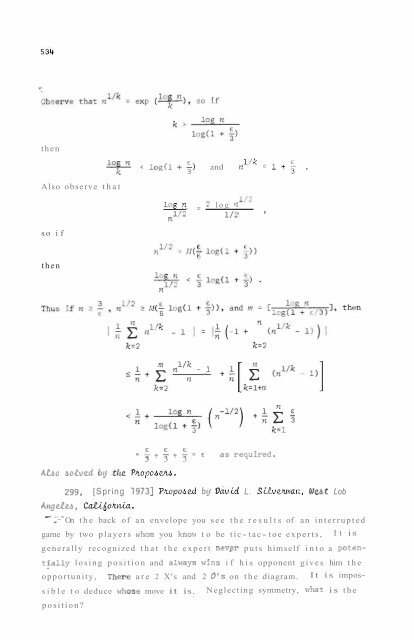You also want an ePaper? Increase the reach of your titles
YUMPU automatically turns print PDFs into web optimized ePapers that Google loves.
thenAlso observe thatso ifthen< log(1 +:) and nl'k < 1 +; .n= 2 log n 1/2l/Z 112 'Let us number the boxes in the tic-tac-toe array along each rowfrom left to right using 1 to 9, Thus the first column is 1-4-7. Ofthe 2 X's and 2 O's, it is clear that :1. lio mark (say X) can occupy box 5, since then a like mark isadjacent to it, so the opposite mark (0) must complete that row or columnor diagonal, The last 0 cannot now be placed so that a win cannot beforced in some way.2. <strong>No</strong> two like marks are symmetric to box 5, since then a like markin box 5 would win or observation 1 would be violated.3, The same mark (say X) cannot appear in two adjacent corners(say 1 and 3), since then 0 must occupy box 2 and some other box thatwould enable 0 to win if he plays next.4. The same mark (say X) cannot appear in two middle-of-an-edgesquares (such as 2 and B or 2 and 4) without violating observation 2(as in boxes 2 and 8) or, if we assume X's in boxes 2 and 4, then 0 mustoccupy the corner (box 1) between the X's and another box (either 6 or8) to prevent X from v~inning with box 5, But then 0 can win with box 9.5. The same mark (say X) cannot occupy two adjacent squares (say 1and 2), since then the opposite mark would have to complete that POW orcolumn ((2 in box 3) and another box, enabling 0 to win if he moves first,6. Thus each mark occupies one corner and one middle-of-an-edgebox (such as 1 and 6) that is opposite. There are four cases.If X lies in 1 and 6 and U in 2 and 9, then X in 4 forces a win forAbo boLved bq .tllc P&opobm,- -E E Ec-+-+-= E asrequired.3 3 3299, [Spring 19731 Pfiopobed bq Uciv.Ld L. S.Zvemtta~~, (Uu.t LobAngdeb, Ca&~o&~ua,4-- On the back of an envelope you see the results of an interruptedgame by two players whom you know to be tic-tac-toe experts,It isgenerally recognized that the expert nevgr puts himself into a puten-tially losing position and always wins if his opponent gives him theopportunity,The~e are 2 X's and 2 0's on the diagram.It is impos-sible to deduce whose move it is. Neglecting symmetry, what is theposition?x *x.If X lies in 1 and 6 and 0 in 2 and 7, then X in 5 forces a win forIf X is in boxes 1 and 6 and if 0 is in 4 and either 3 or 9, thenexpert play will produce a tie in all cases.Hence we have two distinct solutions to the problem* either of whichcould have been on the envelope:
















